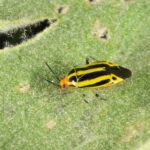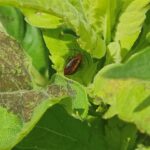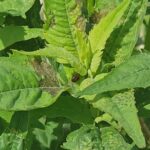Last week I had the wonderful opportunity to visit a local grower who installed an insectary strip adjacent to their high tunnel last year. They will be hosting a field day in June, so I wanted to take a sneak peek and see how the plants (and insects) were doing. The plants are progressing well, a mix of wildflowers, grasses and sedges. Some were even flowering! I was surprised (and stumped) to find some necrotic leaves, especially near the growing tips, on some of the flowers. My NRCS colleagues told me the flowers were in the mint family, so when I first suspected Harlequin bugs, I was a bit confused because I know they have a strong preference for brassica plants but can feed on others.
With my photos in hand (thank you cell phone!) I went on the hunt to figure out what this insect was causing the necrotic tissue damage. As it turns out, this was a new one for me! It is called the Fourlined plant bug! A name that basically described the brightly colored adult that is black with four bright green vertical lines along its back and some red near its head. What I saw were the nymphal stages, little red ‘true bugs’. This insect belongs to the Order Hemiptera, which we call the true bugs and most often have piercing-sucking mouthparts; think aphids, plant hoppers, leaf hoppers, stink bugs, etc.
The feeding damage caused by the Fourlined plant bug results in white-grey spots on the leaf surface, resembling plant pathogens such as fungal infections. In some cases where heavy feeding occurs the spots can coalesce and result in larger necrotic spots or crinkling leaves.
This insect goes through egg-nymph-adult life stages. Eggs are laid on foliage in fall and overwinter. In the spring the eggs hatch and the nymphs are present, dropping to the soil when disturbed. Adults eventually arise, after 3-6 weeks, and are winged. They will fly away when disturbed. There is only one generation per year, and the adults can be found feeding through late July.
The Fourlined plant bug has a wide host range, feeding on over 250 species of plants. They are most seen on herbaceous perennials, herbs such as mint and basil, zinnia, marigold, currants, gooseberries and peppers. This is not an insect that I often encounter in food production. If you are struggling with managing this insect, I suggest sending a sample to the PPDL to confirm identification and get tailored recommendations.
- Figure 1: Fourlined plant bug adult on soybean. Photo by John Obermeyer.
- Figure 2: Fourlined plant bug nymph. Photo by Laura Ingwell.
- Figure 3: Necrotic spots caused by Fourlined plant bug feeding. Photo by Laura Ingwell.



